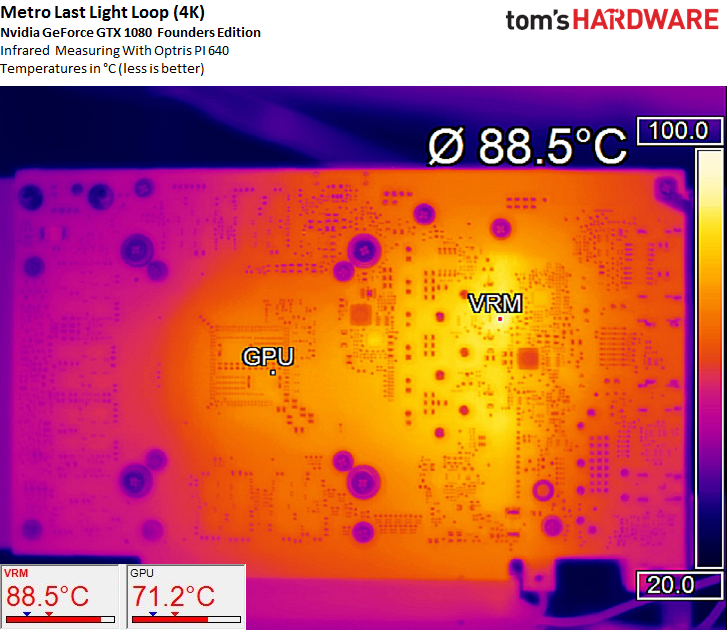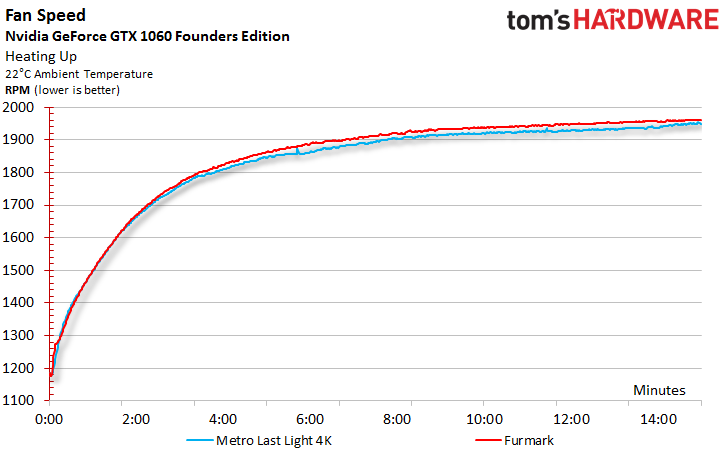Nvidia GeForce GTX 1060 6GB Review
Frequency, Temperature & Noise Results
GPU Boost Clock Rates & Voltages
Let's take a closer look at the overclocked GeForce GTX 1060 in the context of efficiency. We were taking measurements during a gaming loop while it was already hot, and we only looked at average performance. Now we want to know more about what happens as the card warms up.
It’s striking that the GeForce GTX 1060 hits its power and temperature limits. To overclock the card, we increased its GPU Boost frequency, its power target (to 116 percent), and its fan speed (to 100 percent duty cycle). The outcome is nothing to sneeze at: we hit a stable 2050 MHz with our sample during even the worst benchmark run. The curves don’t look as nice without the extra power and airflow to remind us of a leaf blower.
For comparison, let’s take a look at the voltages during normal operation as well. It’s plain to see that the GPU Boost clock and voltages drop once the limit is reached.
Temperatures
The GeForce GTX 1060 generates similar numbers during the gaming loop (119W) and stress test (122W). In light of this, it’s hardly surprising that the two temperature curves look a lot alike. GPU Boost 3.0 is very restrictive (or already well-optimized, if you prefer). It adjusts the clock rate and voltage to keep the card exactly where it’s supposed to be.
The infrared picture tells us that the cooling solution does its job well. All four of the voltage converter areas are in great shape as well.
During the stress test, the GPU’s three voltage converters reach 97 degrees Celsius, which is just within the acceptable range. Then again, nobody runs stress tests for hours, so this result is more theoretical, and not so practical, in nature.
Fan Curves & Noise
Next, we want to quantify just how loud the GeForce GTX 1060 gets under these conditions. The largest source of noise is generally the fan, so we look at that first. Its rotational speed takes a while to plateau, finally stabilizing after about 15 minutes. The two curves are almost on top of each other, which is again hardly surprising seeing that the temperatures the cooler deals with are almost identical as well.
Get Tom's Hardware's best news and in-depth reviews, straight to your inbox.
This leads us to our noise level measurements. As usual, we collect data in our noise-dampened chamber using a silent water-cooled PC. This room-in-a-room concept gets us usable measurements all the way down to 22 dB(A). The hardware in the PC keeps it from being even lower. Then again, we’ll never need to approach that floor for Nvidia's GeForce GTX 1060.
| Test System And Equipment | |
| Microphone | NTI Audio M2211 (with Calibration File, Low Cut at 50 Hz) |
| Amplifier | Steinberg UR12 (with Phantom Power for Microphones) |
| System | Graphics Card Test System with Optimized Water CoolingIntel Core i7-5930K at 4.2 GHz, Water-CooledCrucial Ballistix Sport, 4x 4GB DDR4-2400MSI X99S XPower AC1x Crucial MX200, 500GB SSD (System)1x Corsair Force LS, 960GB SSD (Applications, Data)be quiet! Dark Power Pro, 850W Power Supply Unit (PSU) |
| Water Cooling | - Alphacool VPP655 Pump (Undervolted) - Alphacool NexXxos CPU Cooler - Phobya Balancer - Alphacool 24 cm Radiator - 2x 12 cm Noiseblocker eLoop Fan at 400 RPM |
| Software | Smaart v.7 |
| Measurement Chamber | Custom-Made Proprietary Measurement Chamber, 3.5 x 1.8 x 2.2 m (LxDxH) |
| Measurement Position | Perpendicular to Center of Noise Source(s), Measurement Distance of 50 cm |
| Measurement Data | Noise Level in dB(A) (Slow), Real-time Frequency Analyzer (RTA)Graphical Frequency Spectrum of Noise |
At idle, we measure 31.4 dB(A). This is a good result that’s barely above the noise level encountered in a living room. The sound produced by Nvidia’s radial fan is noticeably more pleasant than that of AMD's reference Radeon RX 480. Nvidia's fan is a bit louder, though.
The good news continues with our gaming loop results. After reaching its maximum temperature, the GeForce GTX 1060 emits just 35.4 dB(A). Motor and bearing noises can’t really be heard above the relatively pleasant swooshing noise produced by the card. The sound isn't as low and growling as what we hear from AMD's competing offering. For more on that card, check out AMD Radeon RX 480 8GB Review.
Even a casual glance at this graph reveals that the majority of the GeForce GTX 1060’s operating noise comes from the fan blades and airflow. The voltage regulation circuitry doesn't contribute at all. This means that the DHE cooling solution performs well, doing its job quietly. Then again, it's not that big of a challenge to dissipate 120W.
MORE: Best Graphics Cards
MORE: Desktop GPU Performance Hierarchy Table
MORE: All Graphics Content
Current page: Frequency, Temperature & Noise Results
Prev Page Efficiency & Over/Underclocking Results Next Page Conclusion-
Vosgy Well with it's price point above the 480 and performance performance difference relatively matching the price difference seems like it will come down to what someone can afford at the time.Reply
Guess I'll recommend either from now on.
Thanks for the review guys, pleasure as always :D -
mitch074 I wonder: with Battlefield 4, why not add the Mantle-enabled rendering path? All existing tests show it to be pretty much equivalent to DX12, and future high-performance, low-latency titles are much more likely to make use of DX12, Vulkan etc. than DX11 or OpenGL...Reply
On that review, as a matter of fact, you use pretty much only DX11 games and only one DX12 title; new API paths are available in Dota2, Talos Principle and Doom 2016... Why not include them, as a reference for the future of gaming, instead of only showing off DX11 games? -
LFCavalcanti You could have included in the value discussion the question about having 2 RX480 in Crossfire vs a single 1070, sort off denying a market place in value for the 1060.Reply
I don't know what NVidia is thinking... their marketing campaign might be stronger than I understand and people will still buy the 1060, but value on it just don't make sense right now. -
BrutalPigeon Where are DX12 reviews? Hitman DX12? Time Spy? 1060 gets rekt in DX12. Nvidia biased review again, also project Cars? How is this even a benchmark, obviously gimped for Radeons.Reply -
kicsako This review is kinda strange. You use Project Cars what is known of running so bad on AMD cards, yet there are no dx/vulkan 12 titles except AOTS. We already have Doom(Vulkan), and Total War+Hitman for dx12. This review is weirdly Nvidia biased. People who buy mid lvl cards are not going to change it for at least 2-3 years. And we will see more and more dx12/vulkan titles yet you only include dx11 games with mostly Nvidia support. Never gona read tomshardware ever again.Reply -
Myrmidonas Yes indeed. I read elsewhere on DX12 benchmarks GTX 1060 does not cope well against rx480. Also, why not DOOM?Reply
Long story short, if you have Win7 and don't plan to upgrade for the next 2-3 years you have a solid reason to get a GTX 1060. The "plot changes" in favor of RX480 if you are going all forward with Win10. -
logainofhades No SLI, on a card of this caliber. Quite the disappointment. Doesn't appear that it quite met the hype. Solid card, at its price point, but still not quite what was expected.Reply -
IceMyth What I understood from this review is either get 1070 or 1080 or RX 480... the 1060 is a waste of money and time since you cant SLI so what you will get will be fixed and to get better gaming you will need to replace the whole GPU to one of the 3 top.Reply
Honestly I expected something decent but seems they released a cheap GPU for NVidia fans rather than to compete with AMD performance and prices! -
AndrewJacksonZA Thank you for the review Chris! It was a pleasure to read high-quality writing with good English - my brain really thanks you! :-)Reply
I would also like to join others in their request for:
- including 2x RX480s in Crossfire (price-wise they are comparable to a 1070,)
- a benchmark using Doom's Vulkan rendering path, and
- results from the TimeSpy benchmark please.
Thank you again for a relaxing and informative read,
Andrew -
cknobman I'd say typical Nvidia cash grab.Reply
A. Card is priced about $50 too high as review kind of indicates.
B. SLI is removed because Nvidia wants you to spend more $$$$$$$ on their higher priced cards. They dont want people trying to achieve playable 4k resolution without paying that Nvidia premium tax.
Right now if I was buying to play 1080-1440 I'd go AMD 480 all the way.









